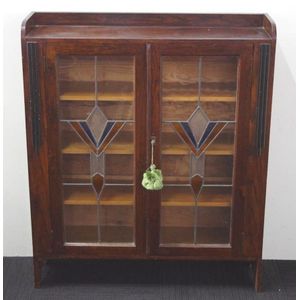Art Deco Leadlight China Cabinet with Key - 89cm
You must be a subscriber, and be logged in to view price and dealer details.
Subscribe Now to view actual auction price for this item
When you subscribe, you have the option of setting the currency in which to display prices to $Au, $US, $NZ or Stg.
- Leadlighting - The use of stained glass, held together with leaded strips, sometimes found in cabinet furniture. While stained glass is not uncommon in Victorian houses, it is unusual to find it in furniture before the end of the 19th century. It was favoured by cabinetmakers for sideboards and smaller pieces such as dinner trolleys, in the style of the Art Nouveau, and is often found in kitchen cabinets and display cabinets dating from the 1930s and 1940s.
- Art Deco Period - The Art Deco period was a cultural movement that emerged in the 1920s and 1930s, and was characterized by its emphasis on modernism, luxury, and elegance. The name "Art Deco" comes from the Exposition Internationale des Arts Décoratifs et Industriels Modernes, a large exhibition held in Paris in 1925 that showcased the latest trends in decorative arts.
Art Deco was a reaction against the ornate and elaborate styles of the previous era, and reflected a new modern sensibility. It was characterized by streamlined, geometric shapes, bright colours, and the use of new materials such as chrome, glass, and Bakelite. Art Deco designers sought to create a sense of luxury and sophistication, often incorporating expensive materials such as ivory, marble, and rare woods.
Art Deco had a significant impact on a wide range of artistic fields, including architecture, fashion, graphic design, and interior design. Some of the most iconic examples of Art Deco architecture include the Empire State Building in New York City, the Hoover Building in London, and the Palais de Chaillot in Paris.
The Art Deco period came to an end in the 1940s, as World War II and changing cultural trends led to a shift in artistic styles. However, Art Deco remains an important influence on design and art, and continues to be celebrated for its modernist sensibility and glamorous aesthetic.
This item has been included into following indexes:
- display cabinets, material - leadlight 39
- display cabinets, period, age or style - Art Deco 56
- furniture, items
Visually similar items

French Louis breakfront parquetry vitrine cabinet, in the Art Deco style, with marble top and glazed door centre flanked by two enclosed cabinets all opening to adjustable shelves, 152 cm wide, 45 cm deep, 143 cm high

A Victorian period walnut long low bookcase with two glazed doors, three adjustable shelves, short serpentine upstand and plinth base. 136 cm x 30 cm x 89 cm

A French burr elm two door armoire, late 19th century, the interior having single shelf, with two half size, drawers. Height 250 cm. Width 145 cm. Depth 54 cm

A Chinese hardwood display cabinet, early 20th century, with a pair of glazed doors and sides enclosing shelves above a pair of drawers and a pair of cabinet doors below, a shaped apron between square-section feet, the cabinet doors carved in relief with s
